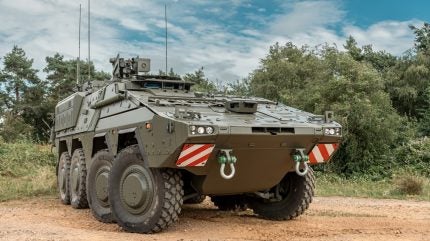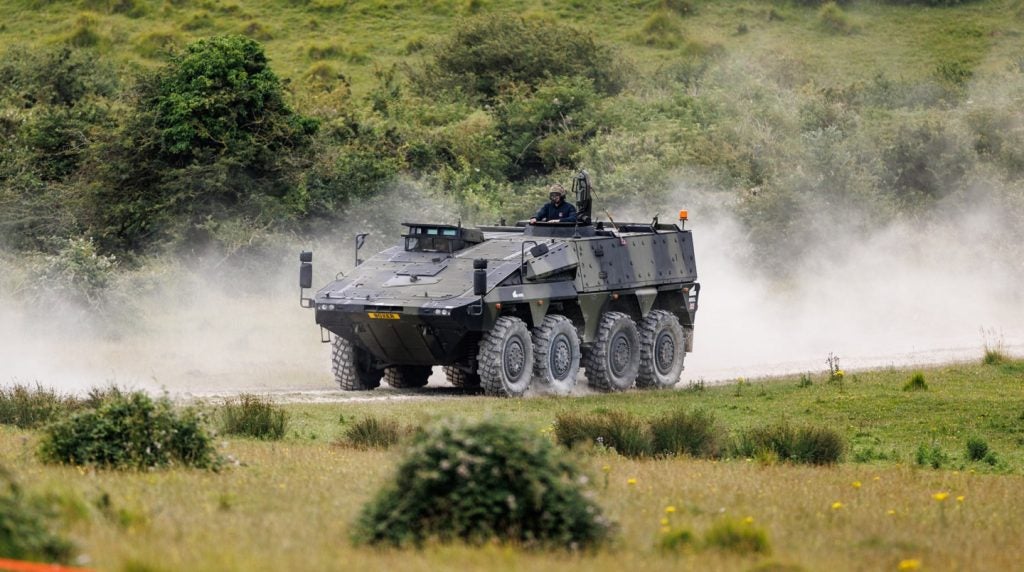
The planned attainment of the British Army’s Boxer mechanised infantry vehicle (MIV) initial operating capability (IOC) by Q4 2025 could be at risk due to global supply chain issues, it has emerged, as the service struggles to modernise an ageing vehicle inventory.
With the British Army’s Ajax armoured cavalry vehicle also recently confirmed as not due to reach IOC until October 2025, two of the service’s landmark programmes are still over one year away from being able to deploy on the battlefield.
Confirming the Q4 2025 IOC timeline for Boxer, the UK government stated on 25 July that “wider global supply chain issues remained a delivery risk” that were being “closely managed”.
It was reported by Army Technology in June 2024 that the British Army’s Boxer MIV had completed live firing trials at the service’s Lulworth Ranges.
The firings represented the first time that British Army soldiers have operated the remote weapon station (RWS) on a UK Boxer platform, firing the general-purpose machine gun, heavy machine gun, as well as the grenade machine gun.
“The accuracy of the fully digital and stabilised RWS has been demonstrated when firing static, at night and on the move,” a British Army post stated at the time.
Supply chain risks were first noted in January this year, as reported by Army Technology, which will see fellow partners in OCCAR’s Boxer programme – Germany, Lithuania and the Netherlands – use their spares parts for the UK Boxers.
This arrangement was reported to have to potential continue for up to two years.
Boxer key element of UK’s new mobile army
The current contract order will see 623 Boxer MIV across a range of variants delivered to the UK, although a June 2023 UK Government statement indicated that funding had been allocated for 1,016 Boxer MIVs against a land requirement of 1,305 units.
In January 2024 the UK MoD said that the Boxer was to begin formal customer validation trials for the command variant platform, coming after the MoD’s Defence Equipment & Support agency received prototype vehicles in December 2023.
The Boxer programme is also being delivered by RBSL from Telford and Stockport, with the European OCCAR agency stating the UK would receive initial operating capability platforms by Q4 2024.
Hollowed out by continued equipment donations to Ukraine, the UK government has a British Army incapable of projecting itself at force, lacking platforms, munitions, and firepower.
The Boxer is a key capability in the British Army’s modernisation efforts as the service looks to reorient itself in a new Nato operating concept amid Russia’s ongoing war in Ukraine.

Delivering a speech to the RUSI Land Warfare Conference 2024 on 23 July, UK Chief of the Defence Staff, Admiral Tony Radakin, said that the unique geography that the UK has “shapes” its role in Nato, giving examples of where countries such as Poland were doubling down on large land formation, the British Army could be different.
“It is why over the past two years I’ve been working with [Nato’s Supreme Allied Commander Europe – SACEUR] to position the (UK-led) Allied Rapid Reaction Corps to become one of NATO’s two Strategic Reserves, with the other being led by France,” Radakin said.
“What SACEUR wants most from the UK is an Army that is more lethal. More mobile. More available. Organised to advance, react and respond at Division, and Corps levels. And equipped to strike faster, harder and deeper.”
Any delays to the IOC of what amounts to be the mobility element of the British Army infantry force could have a significant short term impact on the UK’s ability to deliver what Nato is seeking.







